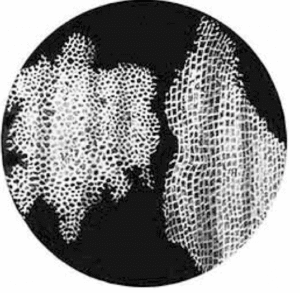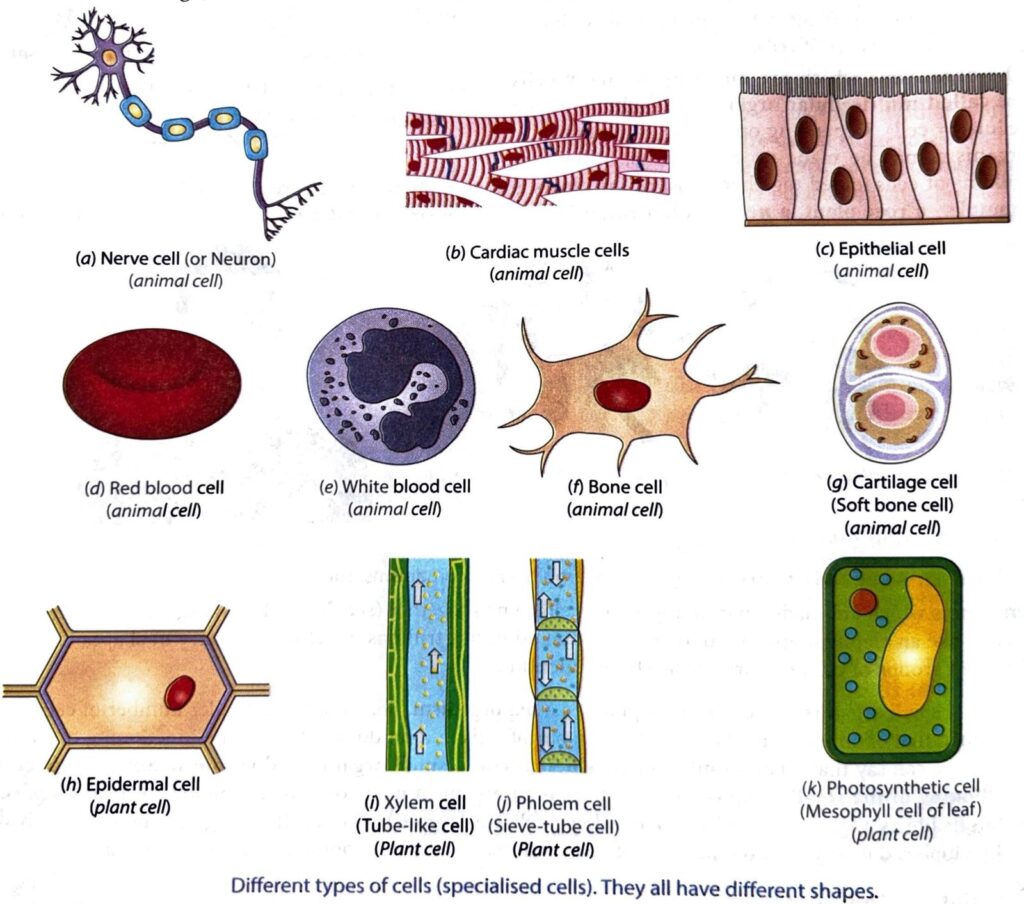All living organisms are made up of tiny units called ‘cells’.Cell is a Latin word meaning ‘a little room’. In biology, cells are the structural and functional units of life.
Discovery

In 1665, a scientist named Robert Hooke, observed a thin slice of cork (a part of bark of the tree) under microscope. It had tiny compartments like small rooms in it. Robert Hooke called these rooms as ‘cells’. He concluded that the cork is made of tiny cells.
Cell theory
German scientists Schleiden and Schwann observed cells in plants and animals and gave a general cell theory of organisms. It states that:
- Cell is the basic unit of structure and function of all living organisms.
- All living organisms are made up of cells.
- All cells come from pre-existing cells.
A cell is the smallest unit of life which has a definite structure and performs a specific function. These are the building blocks of plants and animals.
Cells can be classified into two types: prokaryotic and eukaryotic.
Prokaryotic cells – The cells having nuclear material without a nuclear membrane around it, are called prokaryotic cells. These are simpler in structure. These cells have no real nucleus and nuclear material is in direct contact with the cytoplasm.
The organisms made of prokaryotic cells are called prokaryotes. Example- bacteria and blue-green algae. Prokaryotes are typically single-celled organisms.
Eukaryotic cells- The cells having nuclear material enclosed by a nuclear membrane are called eukaryotic cells. These are more complex and possess a true nucleus bounded by a nuclear membrane.
The organisms made of eukaryotic cells are called eukaryotes. Example- plants, animals, fungi, protozoa, etc. Eukaryotes can be either single-celled (some protists) or multicellular organisms (plants, animals).

Variety in cell number, size and shape
The various organisms differ in the number of cells which make up their body, they differ in shapes of cells in their body; and they also differ in the size of cells in their body.
Number: Depending on the number of cells in an organism, an organism is of two types- unicellular and multicellular.
- The organisms which are made up of a single cell are called unicellular organisms. Example- Amoeba, Paramecium, etc. These organisms are capable of performing all the necessary life functions with one cell.
- The organisms which are made up of many cells are called multicellular organisms. Example- plants, animals, etc. Depending on its size, a multicellular organism may be made up of millions, billions or trillions of cells joined together.
Size: The cells are of many different sizes. The cells in living organisms may be as small as ‘a micrometre’ or it may be as large as ‘a few centimetres’. Most of the cells are extremely small and hence cannot be seen with naked eyes.
- The smallest known cell is Mycoplasma, measuring 0.1 micrometre.
- The biggest cell is the ostrich egg (up to 17 cm long and 13 cm wide).
- In human body, some blood cells are the smallest and the nerve cells are the longest.
Shape: Cells are found in different shapes in an organism. The different shapes of cells are related to their functions.
- Elongated – Nerve cells are elongated and branched.
- Spherical – Red blood cells are small, spherical-shaped.
- Spindle-shaped – Muscle cells are pointed at both ends and have a spindle shape.
- Irregular – Amoeba cell is irregular. It has no fixed shape.

Each living cell has the capacity to perform certain basic functions that are characteristic of all living forms. There is a division of labour in multicellular organisms such as human beings. This means that different parts of the human body perform different functions. The human body has a heart to pump blood, stomach to digest food, lungs for respiration, etc. Each cell has certain components within it, known as cell organelles, to perform a special function.
Parts of a cell
A cell is made up of different parts. Some of the parts are present in all types. But certain parts are found only in plant cells, but absent in animal cells.
A cell has three main components: the cell membrane, the nucleus and the cytoplasm.
- Cell membrane – The outer boundary, controlling what enters and what exists. It is thin and flexible and made up of lipids and proteins. It protects the cell and also gives shape to the cell. It separates the cell from one another.
- Nucleus – It controls all the activities of the cell. It stores the cell’s genetic material (DNA). It is a large, membrane bounded organelle with a nucleolus inside. In animal cells, it lies in the centre of the cell whereas in plant cells, it may be on the periphery of the cell.
- Cytoplasm – The cytoplasm is the gel-like transparent substance which fills the cell between nucleus and cell membrane. It consists of various structures of a cell, known as cell organelles. It provides a medium for organelles to move and carry out their functions. Most of the chemical reactions which keep the cell alive take place in cytoplasm.
